The February personal income and outlays report shows a -0.1% change in real consumer spending, which is not good news for economic growth. Not adjusted for inflation consumer spending rose a scant 0.1%. Real personal income isn't any better with no change for the month. Personal income not adjusted for inflation rose 0.1%. Real disposable income had better news as it increased 0.2% for the month.
Consumer spending is another term for personal consumption expenditures or PCE. Real personal consumption expenditures were $ 11,158.6 billion for February. Consumer spending is roughly about 68% of GDP. Real means adjusted for inflation and is called in chained 2009 dollars
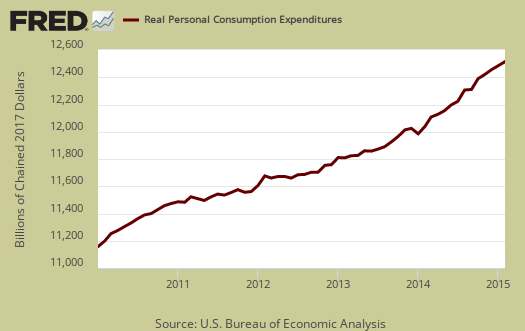
Disposable income is what is left over after taxes and increased 0.2% when adjusted for prices. Graphed below are the monthly percentage changes for real personal income (bright red), real disposable income (maroon) and real consumer spending (blue).

Below are the real dollar amounts for real personal income (bright red), real disposable income (maroon) and real consumer spending (blue) for the last year.

Consumer spending encompasses things like housing, health care, food and gas in addition to cars and smartphones. In other words, most of PCE is most about paying for basic living necessities. Graphed below is the overall real PCE monthly percentage change.
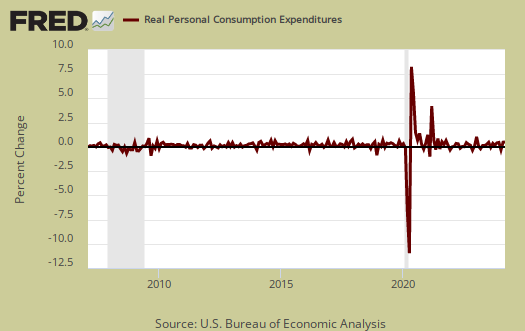
The reason for the decline in spending was durable goods just was hammered. Cars are a durable good sand motor vehicles and parts were identified as the cause for spending on durable good to decline so much. Nondurable goods are things like gasoline and food. Services are things like health care. When people are cutting back on their spending, durable goods are usually the first things to go, especially large ticket items. Below are the real monthly percentage changes in 2009 chained dollars:
- Durable goods: -1.1%
- Nondurable goods: 0.0%
- Services: +0.1%
Price indexes are used as divisors to adjust for inflation and price changes. The indexes are used to compute spending and income for an apples to apples, real dollar comparison to previous months and years. Economic statisticians use real dollars so one does not erroneously assume economic growth when the increase is really just inflation. The PCE price index is also a Federal Reserve inflation watch number. Believe it or not, deflation is bad juju for economic growth and we have price increases below the Fed's target rate. The PCE price index is used to remove inflation from consumer spending and income, reported above as real, or in chained 2009 dollars
The price index increased 0.2%, as gasoline prices increased The price index is now up 0.3% from a year ago. Minus energy and food, the price index increased 0.1% from last month and is up 1.4% from this time last year, below the Fed's 2.0% target rate. While the PCE price index represents inflation, it is different from CPI, although the two typically mirror each other.
Graphed below is the PCE price index, in red, scale on the left, and the PCE price index minus food and energy in blue, scale on the right. This is the percent change from one year ago. We are seeing low inflation similar to the deflationary period of 2008, caused in part by the Great recession and a massive drop in global economic demand. For those watching the Fed raising rates, you might take a look at this article on the Fed's concern for potential deflation.
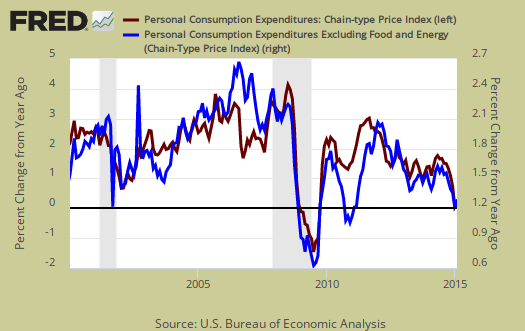
Personal income is total income, from all sources, for everybody in the United States who reported and are not part of the underground economy. Below is personal income, not adjusted for inflation, or price changes. Personal income was an annualized $15,130.9 billion, a 0.4% monthly increase.

The BEA reports real personal income or income adjust for inflation, as real personal income minus transfer receipts. This is government payments, such as social security, removed and also adjusted for inflation. Real personal income minus transfer receipts increased 0.2% for the month. The graph shows how much personal income increased that wasn't funded by the government and is used as a recession indicator as show in the below graph with the gray bars indicating recessions. Transfer receipts are payments from the government to individuals where no actual services (work) was performed. This includes social security, unemployment insurance, welfare, veterans benefits, Medicaid, Medicare and so on.
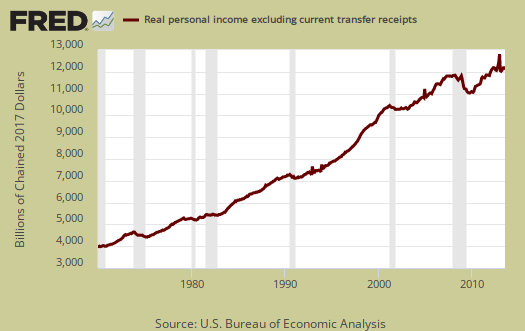
Disposable income is what is left over after taxes. DPI increased 0.4% from last month. DPI adjusted for inflation (see the price indexes above), increased 0.2%, from the previous month. These numbers are aggregates, which includes income of the uber-rich, or the 1% of the population, as they are now called. Below is real DPI by levels.
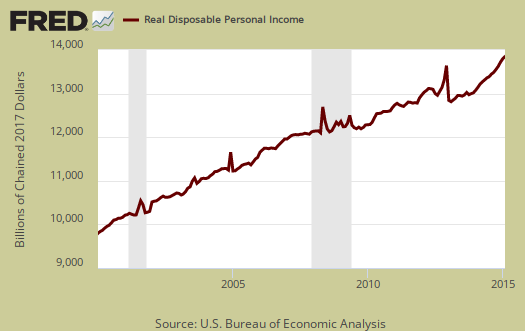
Taxes collected on person income increased 0.2% from last month. Below is a graph of personal income taxes where one can also see the effect of the Bush tax cuts as well as the recession (no income, no taxes on that income), as well as the temporary tax breaks from the Stimulus.

Graphed below is real disposable income per capita. Per capita means evenly distributed per person and population increases every month. While income in the U.S. grows so does the population which earns that total pot of income. Notice how real disposable income per person really started to flatline in 2000. That's just when offshore outsourcing to China started in earnest.
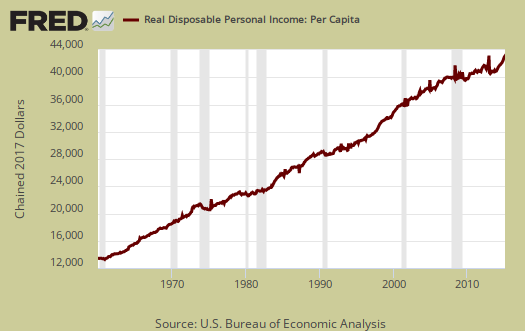
Wages and Salaries increased by 0.3%. Overall employment compensation also increased by 0.3%. Yet lord protect investors as dividends increased 2.8% for the month. Assets are Wall Street income, which most of America doesn't have of which dividends are a part and overall increased 0.9% Rental income increased 0.6% for the month. Every month we see the rich get theirs in dividends, assets and rental income. Graphed below are wages and salaries since 2000. Notice the dip and the more flat line than earlier in the decade. Bear in mind these are aggregate, or all wages and salaries, and not adjusted for inflation.
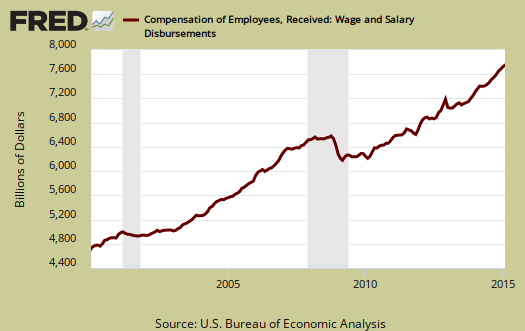
Transfer receipts, which are things like social security increased 0.6%, not adjusted for inflation. Below is a graph of just transfer receipts.

Personal savings is disposable income minus outlays, or consumption and not adjusted for inflation. The Personal Savings Rate was 5.8%.

To visualize more data from this report, consider playing around with more of the St. Louis Federal Reserve Fred graphs. Here are our overviews of personal income & outlays and overviews of GDP are here. This overview details the BEA Personal Income and Outlays statical release, which covers individual income, consumption and savings. The personal income & outlays report is annualized and seasonally adjusted, although most percentages are presented as monthly rates.

change in 1st quarter PCE to date..
rjs
A for the class
thanks for the details.
trade
given that real PCE is about 68% of GDP, we could estimate that real PCE would add 1.06 percentage points to 1st quarter GDP...
however, unless i've made some serious error, the collapse of trade will be the real 1st quarter story...with 2 months in the books, i have 1st quarter exports falling at a 17.1% annual rate, or at a rate that would subtract 2.24 percentage points from 1st quarter GDP, while our overall 1st quarter imports fell at a 19.2% annual rate, or at a rate that would add 2.99 percentage points to 1st quarter GDP..
rjs